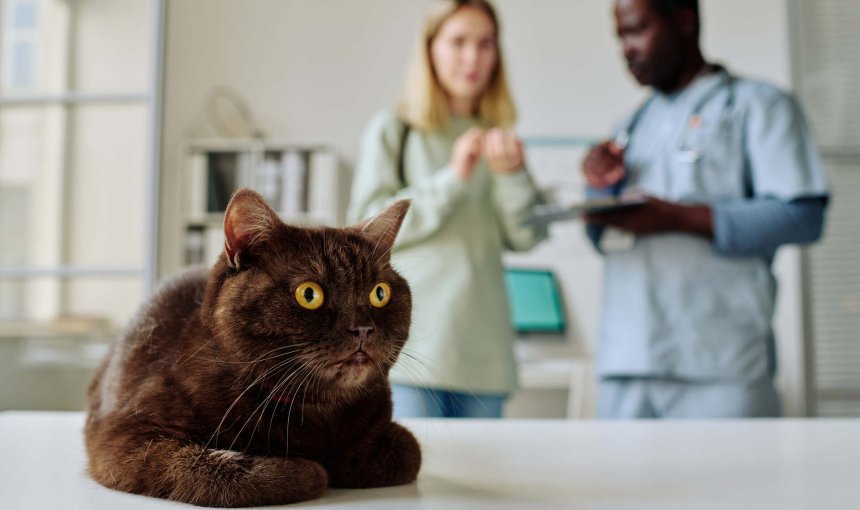17 Cat Diseases That Are More Common Than You’d Think
Cats can’t tell us when something is wrong, but they do give clues. Here are some of the most common cat diseases & how to spot them early.

Cats are masters at hiding their discomfort. That’s why it’s up to us to keep an eye out for signs that they might not be feeling their best. In this post, we’ll go over the most common cat diseases, how to spot them, and which cats are most at risk. We’ll also look at how tools like an smart cat collar with Health Monitoring can act as an early warning system to alert you to changes in your cat’s health.
Key Takeaways
Cats are experts at hiding illness
It’s important for owners to be vigilant and look for subtle signs of a problem because cats are skilled at hiding discomfort.
Be aware of these common diseases
Including feline upper respiratory infections, diabetes, and rabies.
Proactive health care is key
Regular vet check-ups, vaccinations, a healthy diet, and monitoring your cat’s behavior can all go a long way.
A Tractive smart cat collar can be an early warning system
It can detect changes in your cat’s activity level, such as a sudden drop in active minutes. Or, likewise, a change in their sleep quality. This can be an early sign of illness and help you catch problems sooner.

Find out where your cat spends their time.
Read more- Key Takeaways
- 1. Feline upper respiratory infection (URI)
- 2. Feline diabetes
- 3. Feline leukemia virus (FeLV)
- 4. Feline lower urinary tract disease (FLUTD)
- 5. Feline panleukopenia (Distemper)
- 6. Feline immunodeficiency virus (FIV)
- 7. Feline infectious peritonitis (FIP)
- 8. Feline hyperthyroidism
- 9. Chronic kidney disease (CKD)
- 10. Dental disease
- 11. Rabies
- Symptoms of rabies in cats
- Which cats are at risk?
- 12. Worms
- Symptoms of worms in cats
- Which cats are at risk?
- 13. Flea allergic dermatitis (FAD)
- Symptoms of FAD in cats
- Which cats are at risk?
- 14. Cat flu
- Symptoms of flu in cats
- Which cats are at risk?
- 15. Pyometra
- Symptoms of pyometra in cats
- Which cats are at risk?
- 16. Osteoarthritis
- Symptoms of osteoarthritis in cats
- Which cats are at risk?
- 17. Inflammatory bowel disease (IBD)
- Symptoms of IBD in cats
- Which cats are at risk?
- Common signs of illness or disease in cats
- Top tips on how to keep your cat healthy
- Where a smart cat collar can help you spot illness early
Here are some of the most common diseases in cats, including how they’re spread, what symptoms to watch out for, and which cats are more likely to develop it.
1. Feline upper respiratory infection (URI)
Just like a human cold, URIs in cats are most commonly caused by viruses or bacteria. These are most often spread when cats sneeze, cough, or groom near shared food or water bowls. Once infected, cats often carry these diseases for life and continually transmit them to others.
Symptoms of URI in cats
- Sneezing, runny nose
- Watery or gooey eyes
- Nasal discharge, both clear or colored
Which cats are at risk?
- Kittens, shelter cats
- Cats in multi-cat households
- Elderly cats
2. Feline diabetes
Diabetes in cats occurs when their bodies cannot produce or use insulin properly. Which results in hyperglycemia or high blood sugar, which can lead to worse health problems for your cat – including kidney disease, neurological diseases, and even other metabolic disorders.
Symptoms of diabetes in cats
- Increased thirst/urination
- Weight loss despite eating
- Sweet-smelling breath
Which cats are at risk?
- Overweight cats
- Middle-aged to senior cats
3. Feline leukemia virus (FeLV)
FeLV is a contagious viral disease that can suppress the immune system. This virus usually doesn’t show many visible symptoms right away, but is commonly spread through bodily fluids, direct contact, shared litter boxes or food bowls, or even through bites and scratches.
Symptoms of FeLV in cats
- Lethargy
- Fever
- Pale gums
- Poor coat conditions
Which cats are at risk?
- Outdoor cats
- Kittens
4. Feline lower urinary tract disease (FLUTD)
FLUTD can cause discomfort and difficulty urinating. Broadly, it describes a whole bunch of common bladder and urethra conditions that cats might develop at any age. Watch out if your cat is visiting the litter box multiple times but without much success.
Symptoms of FLUTD in cats
- Straining to urinate
- Blood in urine
- Excessive grooming of the belly
Which cats are at risk?
- Overweight cats
- Male cats
- Cats living in stressful conditions
5. Feline panleukopenia (Distemper)
A highly contagious and often fatal viral disease – but which is preventable through vaccination. Distemper spreads through direct contact with infected cats, contaminated food or water bowls, or even on surfaces touched by the virus.
Symptoms of distemper in cats
- Vomiting
- Diarrhea
- Fever
- Loss of appetite
Which cats are at risk?
- Unvaccinated cats
- Outdoor cats
- Cats in shelters
6. Feline immunodeficiency virus (FIV)
FIV is a viral infection that compromises a cat’s immune system, making them more susceptible to other infections. It tends to spread primarily through bites and scratches that draw blood, but also from direct contact through grooming or shared food bowls. Neutering your male cat can be an important step to reducing the spread of FIV.
Symptoms of FIV in cats
- Persistent fever
- Enlarged lymph nodes
- Chronic infections
Which cats are at risk?
- Unneutered males
- Outdoor cats
- Cats involved in fights
7. Feline infectious peritonitis (FIP)
FIP is a fatal viral disease caused by a mutation of the feline coronavirus. It has two forms – a wet form, which leads to fluid buildup in the abdomen or chest, and a dry form, which causes inflammation in the organs. FIP often spreads through infected feces or saliva.
Symptoms of FIP in cats
- Abdominal swelling
- Weight loss
- Lethargy
Which cats are at risk?
- Kittens
- Cats with weak immune systems
- Cats in shelters
8. Feline hyperthyroidism
Hyperthyroidism is a common endocrine disorder in older cats. It’s when your cat’s thyroid gland is on overdrive, producing more of the thyroid hormone than usual. Treatment options include medication, dietary changes, and radiocative iodine therapy.
Symptoms of hyperthyroidism in cats
- Weight loss despite eating
- Increased thirst and urination
- Hyperactivity
Which cats are at risk?
- Older cats (over 10 years)

Get health alerts for your cat
Our cats can’t always tell us if something’s wrong. But if their tracker detects unusual changes in their routine, you’ll get an alert, helping you catch potential issues early.
9. Chronic kidney disease (CKD)
CKD is a common condition in older cats where the kidneys gradually lose function. Sadly, these changes are often irreversible. Cats of any age can be affected.
Symptoms of CKD in cats
- Weight loss
- Increased thirst and urination
- Poor coat condition
Which cats are at risk?
- Older cats
- Cats with a history of kidney issues
10. Dental disease
Dental issues, including periodontal disease, are common in cats and can lead to significant pain and health problems. Between 50-90% of cats have some form of dental disease, often showing no symptoms until their condition worsens.1
Symptoms of dental disease in cats
- Bad breath
- Drooling
- Difficulty eating/reluctance around meals
Which cats are at risk?
- Cats over 3 years old
- Cats on soft diets
11. Rabies
Rabies is a fatal viral disease affecting the brain and spinal cord of all mammals. It can infect cats, dogs, and humans alike – but it’s preventable via vaccine. (Make sure to check your state laws regarding whether it’s mandatory.) It’s most often transmitted through bites and saliva from an infected animal, or through fresh open wounds.
Symptoms of rabies in cats
- Behavioral changes
- Aggression
- Lethargy
- Excessive drooling
Which cats are at risk?
- Unvaccinated cats
- Outdoor cats
12. Worms
Parasitic worms, such as roundworms and tapeworms, are common in cats. They can even pass via mother’s milk, infected feces, skin contact, or even the animals your cat hunts (like mice.) Staying on top of your anti-parasite treatment can help prevent these problems – since at least some of these worms can also pass on to humans.
Symptoms of worms in cats
- Vomiting
- Diarrhea
- Weight loss
- Visible worms in feces
Which cats are at risk?
- Kittens
- Outdoor cats
13. Flea allergic dermatitis (FAD)
This condition is an allergic reaction to flea saliva. Fleas can cause itchy bites on cats, dogs, and humans too – even leading to anemia, in some serious cases. Regular flea prevention can help treat allergies and stop them from spreading.
Symptoms of FAD in cats
- Intense itching
- Hair loss
- Scabs
- Red, irritated skin
Which cats are at risk?
- Cats with flea exposure
- Outdoor cats
14. Cat flu
Cat flu is a common viral infection causing cold-like symptoms. It’s caused by a whole bunch of viruses and bacteria, including the Herpes virus and Bordetella bronchiseptica. Cats of any age can be affected.
Symptoms of flu in cats
- Sneezing
- Nasal discharge
- Watery eyes
- Fever
- Lethargy
Which cats are at risk?
- Kittens
- Unvaccinated cats
15. Pyometra
Pyometra is a life-threatening uterine infection in unspayed female cats. Symptoms usually begin within 6 weeks of your cat’s last heat cycle. This is an urgent condition and may necessitate surgical removal of your cat’s uterus.
Symptoms of pyometra in cats
- Lethargy
- Vaginal discharge
- Increased thirst/urination
Which cats are at risk?
- Older female cats
- Unspayed female cats
16. Osteoarthritis
Osteoarthritis is a degenerative joint disease. With time and age, it causes the breakdown of cartilage in a cat’s joints, leading to pain and stiffness. Because the signs are so subtle, it often goes undiagnosed.
Symptoms of osteoarthritis in cats
- Difficulty jumping or getting around
- Limping or stiffness
- Reluctance to play
- Matted, unkempt fur from poor grooming
Which cats are at risk?
- Older cats
- Overweight cats
- Cats with prior injuries
17. Inflammatory bowel disease (IBD)
Inflammatory Bowel Disease (IBD) is a chronic condition where a cat’s gastrointestinal tract becomes inflamed because of an abnormal immune response. This inflammation makes it difficult for your cat’s body to absorb nutrients, which can leave your cat malnourished despite eating. IBD can be triggered by food allergies, infections, or even stress.
Symptoms of IBD in cats
- Chronic vomiting
- Diarrhea
- Weight loss despite eating
Which cats are at risk?
- Middle-aged to senior cats
- Cats with sensitive stomachs
- Cats with food allergies
Common signs of illness or disease in cats
Your cat might not be able to complain to you that they’re feeling poorly – though not for lack of trying! Which is why you should drop by your vet if you notice:
- A drop in activity levels
Cats that are normally playful or active might start spending more time sleeping or lying down. - Changes in appetite
Eating or drinking significantly less or more than usual could indicate a problem. - Lethargy or weakness
A sudden lack of energy is a red flag. - Vomiting or diarrhea
While occasional hairball-related vomiting is normal, persistent symptoms aren’t. - Unexplained weight loss
Gradual or sudden weight loss can point to underlying health issues. - Changes in grooming habits
A decrease in grooming or over-grooming specific areas might indicate discomfort or illness. - Behavioral changes
Increased hiding, aggression, or clinginess are worth noting.
Read more: 10 Signs Of Illness In Cats
Top tips on how to keep your cat healthy
Whether it’s a subtle change in behavior or a noticeable drop in activity, being proactive about your cat’s health can make all the difference. Here are some steps you can take to keep your cat healthy:
- Regular veterinary check-ups
Schedule annual visits, or more frequently for senior cats, to catch potential issues early. - Vaccination and deworming
Ensure your cat is up to date on vaccinations and parasite prevention. - Healthy diet & exercise
Feed a balanced diet and engage your cat in regular play to maintain their ideal weight. - Hygiene & grooming
Brush your cat regularly and check for signs of fleas, ticks, or skin issues. - Monitor behavior
Keep a close eye on your cat’s activity, eating, and litter box habits for any unusual changes.
Where a smart cat collar can help you spot illness early
You might think of smart collars with GPS tracking for lost pets. But modern devices like the Tractive smart cat collar also include Health Monitoring features for early illness detection. Cats are masters at hiding signs of pain or sickness, so subtle changes in their behavior are often the only clue that something is wrong. A smart collar provides objective data to help you see these changes before they become obvious.

Strapped to their collar, you can now:
Monitor your cat’s activity
With its built-in motion detector, Tractive monitors your cat’s activity levels throughout the day, tracking active minutes and calories burned. A sudden drop in activity, a decrease in their usual zoomies, or a general increase in lethargy can be a strong indicator of an underlying health problem. By establishing a baseline of your cat’s normal activity, the tracker makes it easy to spot a deviation from their routine, which could be a sign of anything from joint pain to a more serious infection.
Keep tabs on your cat’s sleep
Just as with activity, Tractive also provides insights into your cat’s sleep patterns. You can see how much they sleep in a 24-hour period and if their sleep is being interrupted. A significant increase in sleep, or a change in their sleep schedule, could point to illness, stress, or other issues. For instance, if your cat is normally active at night but suddenly starts sleeping more, it might be a sign they aren’t feeling well.
Spot potential health issues early
Tractive takes the raw data from activity and sleep tracking and turns it into actionable insights. After the tracker has established a baseline of your cat’s normal routine, it can send you an email or app notification – a “Health Alert” – if there are significant, lasting changes in your cat’s activity or sleep patterns. These alerts act as an early warning system, prompting you to talk to your vet before the issue becomes a major problem. This data also means you’re likely to have a more productive conversation with your vet.
And if you’ve liked this post, share it with a friend or a loved one – and let’s help build a safer, kinder world for our furry friends together.



